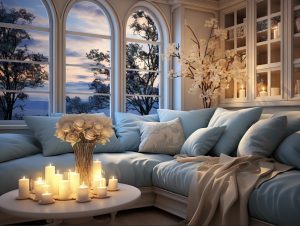Interior Design Tips For Homeowners

Interior design is a creative and imaginative process. You get the chance to take liberties with your space, incorporating your unique sense of style to create a cohesive and welcoming environment. In this article, we delve into eight astute interior design tips to transform your home into a beautiful sanctuary.
Understanding Your Personal Style
Every homeowner has their unique style preferences, and the first step in any interior home design is understanding your personal style. This requires keen introspection and a multitude of observations. Do you gravitate towards minimalist design, or are you enthralled by the grandeur of traditional styles? The essence of effective interior design lies in aligning your space with your personality and lifestyle.
Your style preference will dictate the color schemes, furniture, and decor elements you choose for your home. Discovering your style might seem challenging initially. However, you can make this process enjoyable by scrolling through various designs on platforms like Pinterest or watching home makeover TV shows. Soon enough, you will start noticing patterns in your likes and dislikes, guiding you toward defining your personal style.
Moreover, don’t forget to focus on functionality as you design your room. The placement of your furniture should not just look aesthetically pleasing; it should also ensure easy movement and accessibility. For instance, investing in a versatile piece like an upholstered bench not only enhances the visual appeal but also provides seating.
The Interplay of Lights and Colors
Light and color are intrinsic elements of any design scheme. They create emotion, add depth, and establish the mood in the environment. The choice of color directly influences the ambiance of a space. For example, the use of neutral colors can create a calm and relaxing mood, while bold colors bring energy and vitality. It’s essential to consider the lighting conditions of your room before deciding on a color scheme. Natural light can make colors appear differently at different times of the day.
Lighting impacts not only the mood and ambiance but also the perceived size of a room. The right use of lights can make space appear bigger or cozier as desired. Layering your light sources, such as ambient lighting, accent lighting, and task lighting, can dramatically transform your space. Remember, lighting is not restricted to just overhead fixtures or table lamps; think about incorporating light into your furniture or decor pieces for a unique touch.
The color of your lights should complement your color scheme. Cool white lights work well in modern, contemporary designs, while warm yellow lights lend a cozy, welcoming vibe that is ideal for traditional or rustic designs.
Importance of Layout and Space Management
Good layout and space management create a sense of harmony and balance in a room. It is the art of arranging your furniture and decor in a way that maximizes space, promotes a good flow of movement, and creates functional and aesthetically pleasing areas within your room. Assessing the size and shape of your room is crucial in this step. Think about how you can strategically place each piece of furniture to make the room feel balanced.
For small spaces, consider multifunctional furniture that conserves space yet serves various purposes. For instance, an ottoman that doubles up as a storage unit can be a great addition. For larger rooms, determine how you can divide the space into different functional areas without making it feel empty or unbalanced.
Remember, less is often more when it comes to interior design. Essentially, you don’t need to fill up every bit of space. Your room needs space to breathe, and uncluttered spaces often look more elegant and spacious.
Careful Selection of Furniture and Decor
The furniture and decor you select can make or break your design. Consider the color, material, size, and design of the furniture. Does it align with your style? Does it fit the room without overcrowding it? An oversized sofa might look fabulous in the store, but it could look out of place if your living room has limited space. Similarly, the choice of materials for your furniture, upholstery, and decor also plays an essential role in achieving a cohesive look.
When decorating, consider texture variety to add depth and interest to the decor. Mix and match different materials like wood, metal, fabric, and glass. Accessories provide the finishing touches to the design. This could include elements like throws, cushions, rugs, artwork, and indoor plants. Pay attention to the scale and proportion of these elements to ensure they harmonize with your furniture and the overall style.
Finally, remember that these elements should not only be visually pleasing but also comfortable and functional. Your home is a place for relaxation and leisure, so prioritize comfort when selecting your furniture and decor. When you shop from a trusted retailer like Serena & Lily, you can ensure that you are getting high-quality pieces that are durable, functional, and comfortable.
Incorporating Personal Touches
Adding personal touches to your space truly helps your house feel like home. This can be through family photos, heirlooms, travel souvenirs, or art pieces. These personal items tell your unique story and add a layer of intimacy and personality to your space. They can be a source of conversation when you host guests and create a sense of familiarity and comfort for you and your family.
However, be mindful of how you display these personal items. They need to be cohesive with your overall design scheme. Placing a brightly colored souvenir in a room with a neutral color palette might make it stand out awkwardly. Similarly, crowding too many items together can make the space feel cluttered and chaotic.
One way to beautifully incorporate personal items is by dedicating specific areas or shelves for them. This way, they get their spotlight without overwhelming the design.
Taking Risks with Your Design
It’s your home, and while following design rules and guidelines is helpful, don’t be afraid to break them and go with your instincts. If you feel that a certain design element or style resonates with you, even if it is unconventional, go for it. Having fun with the process is integral to creating a design that truly feels like your own.
Experimentation can lead to amazing results. Mixing traditional and modern elements, painting one wall a bold color while keeping the others neutral, or hanging an oversized piece of art in a small room can create a stunning visual impact. Remember, the best designs are those that reflect the people living in their homes, not just the current trends.
Also, don’t feel pressured to design your home all at once. Taking your time allows you to thoroughly plan each step, gather the necessary items, and make more thoughtful decisions. Remember, good design is a process that evolves over time, and rushing this process can compromise the ultimate result.
The Role of Greenery in Interior Design
Incorporating greenery in your home’s design is an excellent way to bring nature indoors and add a refreshing touch to your setting. Indoor plants purify the air and create a serene, calming environment, and come with numerous other science-backed benefits. They add life and vibrance to any room and can be a part of your decor as well.
There are a multitude of plants to choose from depending on the amenities of your home. Some plants thrive in bright sunlight, while others are perfectly suited for low-light conditions. Consider the room’s light availability, temperature, and humidity levels while selecting indoor plants. Alternatively, you can also opt for artificial plants, which are easier to maintain.
Consider using plants of various heights and sizes for a layered look. Hanging plants or wall-mounted plant holders can also be an interesting addition to your decor.
Overall, interior design is a creative endeavor that allows you to express yourself and create a home that’s reflective of your personality. By using these tips as a starting point, you can begin to formulate a design that’s uniquely you. Remember, your home is your sanctuary, and designing it should be an enjoyable and fulfilling process.






